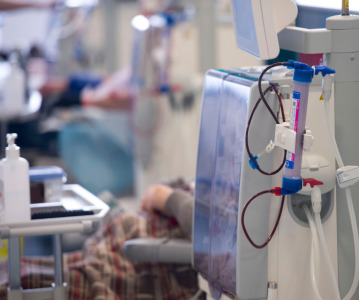2017: A year of innovation and advances

A summary and highlights of new drug therapy approvals and other drug therapy advances in 2017 by FDA's CDER.
In 2017, FDA's Center for Drug Evaluation and Research's (CDER's) new drug therapy approvals helped a wide range of patients suffering from many different medical conditions to gain new hope for improved quality of life and in some cases, improved chances of surviving life-threatening illnesses.
Rare Diseases
Among many other new approvals to help patients with rare diseases, CDER approved the first new treatment for patients with sickle cell disease in almost 20 years and the first non-blood product to treat patients with hemophilia A with inhibitors. For the first time, a treatment is available for adults diagnosed with giant cell arteritis. CDER also approved a new treatment for Batten disease.
Infectious DiseasesCDER approved a new antibiotic to treat certain types of serious skin infections and another to treat complicated urinary tract infections, including kidney infections. They also approved two new treatments for certain patients with chronic hepatitis C; a new drug to help prevent cytomegalovirus infection in patients who have received a bone marrow transplant; and the first therapy in the US to treat Chagas disease.
Neurological DisordersLast year was a particularly productive year for approving new therapies for patients with neurological disorders. CDER approved new therapies to treat patients with tardive dyskinesia, myasthenia gravis, Duchenne muscular dystrophy, certain forms of multiple sclerosis, amyotrophic lateral sclerosis, and for Parkinson's disease.
Cancer Therapies2017 was another strong year for making new cancer therapies available. CDER approved new therapies for certain patients with acute lymphoblastic leukemia; Merkel cell carcinoma; certain forms of relapsed or refractory acute myeloid leukemia; certain forms of lymphoma; recurrent epithelial ovarian, fallopian tube, or primary peritoneal cancer; and specific forms of liver, breast, and colorectal cancer. Furthermore, the first cancer treatment based on a genetic feature of a cancer rather than the location of the body where the tumor originated was also approved.
Other AdvancesCDER approved a new therapy for decreasing heart risk for patients with diabetes; a new drug to treat patients with moderate-to-severe eczema; and three therapies to treat patients with moderate-to-severe plaque psoriasis. CDER also approved the drug in the US with a sensor embedded in the pill that records that the medication was taken. CDER also worked with pharma manufacturers with facilities that were affected by the 2017 Hurricane Season, to address potential drug shortages.
In 2017, CDER approved a wide variety of drug therapies to improve the health of the American public, including the following:
Novel DrugsIn 2017, CDER approved 46 novel drugs either as NMEs, NDAs or BLAs. Of these 46 novel drugs.
In 2017, CDER met its PDUFA goal dates for 100% of the novel drugs approved; it also approved 39 of the 46 novel drugs in the 'first cycle' of review. Thirty six of the 46 novel drugs were approved in the US before receiving approval in any other country.
New Uses and Expanded Uses of Already FDA-Approved DrugsIn 2017, CDER approved five new biosimilars:
Notable approvals in this category include the following:
Related News
-
News US FDA adds haemodialysis bloodlines to devices shortage list
On March 14, 2025, the US FDA published an open letter to healthcare providers citing continuing supply disruptions of haemodialysis bloodlines, an essential component of dialysis machines. -
News Vertex Pharmaceuticals stock jumps as FDA approves non-opioid painkiller
UK-based Vertex Pharmaceuticals saw their stock shares soar as the US FDA signed off on the non-opioid painkiller Journavx, also known as suzetrigine, for patients with moderate to severe acute pain, caused by surgery, accidents, or injuries. -
News Lessons from CPHI Milan 2024: Sunny Intervals for Pharma Manufacturing?
As the 2024 CPHI conference wrapped up in Milan, we caught up with L.E.K. Consulting – a global strategy consulting firm with deep expertise in pharma manufacturing – to discuss evolving market perspectives and business outlook. -
News US BIOSECURE Act passed by US House of Representatives
The controversial act, which has already impacted several foreign companies operating in the US, was passed by the House of Representatives on September 9, 2024. It is now headed for the US Senate before it can be signed into law by President Joe Biden... -
News Pharma Supply Chain People Moves
The latest appointments, promotions, and structural changes across the pharmaceutical supply chain. -
News Drug prices agreed upon as part of the US Inflation Reduction Act
The Inflation Reduction Act brought into constitution by the Biden administation in 2022, which proposed a drug price negotiation between the government and pharmaceutical companies, has reached it's first agreement. -
News BIOSECURE Act continues to loom over Chinese pharma manufacturers
With the US BIOSECURE Act on its way to passing into legislation, Chinese companies are facing declining revenues within the first half of 2024 as US pharmaceutical and healthcare companies pull their businesses from the country. -
News Ophthalmologic drug product Eylea faces biosimilar threats after FDA approvals
Regeneron Pharmaceutical’s blockbuster ophthalmology drug Eylea is facing biosimilar competition as the US FDA approves Biocon’s Yesafili and Samsung Bioepis/Biogen’s Opuviz.
Recently Visited
Position your company at the heart of the global Pharma industry with a CPHI Online membership
-
Your products and solutions visible to thousands of visitors within the largest Pharma marketplace
-
Generate high-quality, engaged leads for your business, all year round
-
Promote your business as the industry’s thought-leader by hosting your reports, brochures and videos within your profile
-
Your company’s profile boosted at all participating CPHI events
-
An easy-to-use platform with a detailed dashboard showing your leads and performance






.png)
.png)